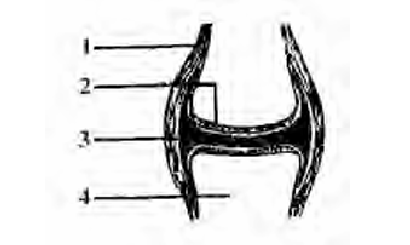Skeletal System QUestions
Objective Questions
Starting from the skull end, the vertebrae are arranged in the following order:
Correct Answer: (D) Atlas, axis, cervical, thoracic, and lumbar
The axial skeleton of a mammal does not include the bones of the:
Correct Answer: (C) Limbs
Muscles are indirectly attached to bones by means of:
Correct Answer: (C) Tendons
The bone of the neck on which the skull rests is known as the:
Correct Answer: (C) Atlas
Use the diagram to answer number 5 and 6

The part labeled 3 is the:
Correct Answer: (C) Synovial fluid
The function of the part labeled 1 is to:
Correct Answer: (A) Secrete a fluid which lubricates the joint
A band of connective tissue linking two bones in a joint is known as:
Correct Answer: (D) Ligament
The appendicular skeleton is composed of the:
Correct Answer: (A) Pelvic girdle, fore and hind limbs
Which of the following is not a function of the mammalian skeleton?
Correct Answer: (C) Transportation
The organism that has a hydrostatic skeleton is:
Correct Answer: (B) Hydra
The chitin in the exoskeleton of many arthropods is strengthened by:
Correct Answer: (A) Calcium compounds
The scapula and the ischium are part of the:
Correct Answer: (B) Pelvic girdle
Which of the following has no skeleton at all?
Correct Answer: (B) Sponge
How many bones are there in the human body?
Correct Answer: (C) 206
In the human body, the longest bone is in the:
Correct Answer: (B) Femur
The odontoid process is found in the vertebra:
Correct Answer: (B) Axis
Which of the vertebrae provide attachment for abdominal muscles?
Correct Answer: (C) Lumbar vertebrae
The main types of materials found in the skeleton of animals include the following except:
Correct Answer: (B) Marrow
The main types of skeletons in animals include the following except:
Correct Answer: (B) Hydroscopic
_____ holds the upper limbs or arms to the axial skeleton:
Correct Answer: (A) Pectoral girdle
Theory Questions
Describe the features of a typical vertebra
Name three bones each of the (a) fore-limb (b) hind limb.
Explain briefly the three (3) types of skeleton in animals
Define a joint. Give two examples each of (a) hinge joint (b) ball and socket joint
State three biological significance of skeleton in the life of living organisms